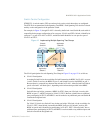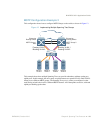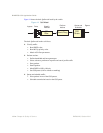
BLADEOS 6.5.2 Application Guide
BMD00220, October 2010 Chapter 8: Spanning Tree Protocols 127
Multiple Spanning Tree Protocol
Multiple Spanning Tree Protocol (MSTP) extends Rapid Spanning Tree Protocol (RSTP), allowing
multiple Spanning Tree Groups (STGs) which may each include multiple VLANs. MSTP was
originally defined in IEEE 802.1s (2002) and was later included in IEEE 802.1Q (2003).
In MSTP mode, the G8124 supports up to 32 instances of Spanning Tree, corresponding to
STGs 1-32, with each STG acting as an independent, simultaneous instance of STP.
MSTP allows frames assigned to different VLANs to follow separate paths, with each path based on
an independent Spanning Tree instance. This approach provides multiple forwarding paths for data
traffic, thereby enabling load-balancing, and reducing the number of Spanning Tree instances
required to support a large number of VLANs.
Due to Spanning Tree’s sequence of discarding, learning, and forwarding, lengthy delays may occur
while paths are being resolved. Ports defined as edge ports (“Port Type and Link Type” on
page 131) bypass the Discarding and Learning states, and enter directly into the Forwarding state.
Note – In MSTP mode, Spanning Tree for the management ports is turned off by default.
MSTP Region
A group of interconnected bridges that share the same attributes is called an MST region. Each
bridge within the region must share the following attributes:
Alphanumeric name
Revision number
VLAN-to STG mapping scheme
MSTP provides rapid re-configuration, scalability and control due to the support of regions, and
multiple Spanning-Tree instances support within each region.
Common Internal Spanning Tree
The Common Internal Spanning Tree (CIST) provides a common form of Spanning Tree Protocol,
with one Spanning-Tree instance that can be used throughout the MSTP region. CIST allows the
switch to interoperate with legacy equipment, including devices that run IEEE 802.1D (1998) STP.
CIST allows the MSTP region to act as a virtual bridge to other bridges outside of the region, and
provides a single Spanning-Tree instance to interact with them.
CIST port configuration includes Hello time, path-cost, and interface priority. These parameters do
not affect Spanning Tree Groups 1-32. They apply only when the CIST is used.


















